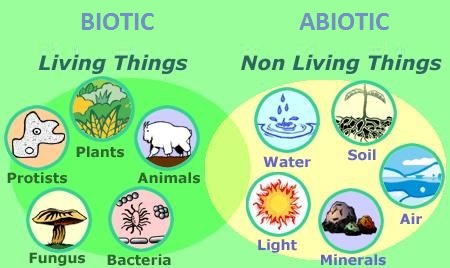biotic factor
noun Ecology.
Words nearby biotic factor
HOMEWORK HELP
What is a biotic factor?
A biotic factor is any living thing that has an effect on an ecosystem.
Biotic means “pertaining to life.” A factor is something that influences another thing. So, a biotic factor, put simply, is a living thing that affects other things.
A biotic factor is also called a biotic component. Be careful not to confuse biotic factor with abiotic factor. Abiotic factors are nonliving entities that affect ecosystems (for example, rain, sunlight, and rocks).
Biotic factors vs. abiotic factors
The “circle of life” is more than just a saying. Each part of an ecosystem affects the other parts. Biologists separate the aspects of an ecosystem into biotic and abiotic factors. If you’re reading this sentence, you’re a biotic factor. Why? Because a biotic factor is any living thing that is part of an ecosystem.
Biotic factors are essential in understanding how ecosystems work. There are three main types of biotic factors: producers, consumers, and decomposers. These are also called autotrophs, heterotrophs, and detritivores (respectively).
Producers (autotrophs) are popularly called “self-feeders” because they convert energy into food through photosynthesis. Examples include:
- trees
- grass
- phytoplankton
Consumers are called heterotrophs (“other-eaters”) because they eat other organisms as food. They can be herbivores (like koalas, cows, and iguanas), carnivores (like sharks, foxes, and lions), or omnivores (like humans, chickens, and turtles).
Lastly, decomposers are called detritivores (“waste-eaters”). They break down the remains of consumers and producers into simpler forms that can be used again. Here are a few familiar types:
- bacteria
- worms
- mushrooms
Biotic factors and abiotic factors affect each other and influence the world around us. When the weather (an abiotic factor) gets really cold, certain birds (biotic factors) migrate south. On the other hand, if human activity (another biotic factor) pollutes a river, that affects what can live and grow there.
Did you know ... ?
Organisms are still considered biotic factors even after they die. So, a rotting tree is still a biotic factor even though it’s not alive because, at one point, it was alive. The line between biotic and abiotic becomes blurrier when a deceased biotic factor starts to decompose, however.
What are real-life examples of biotic factor?
Identifying objects as biotic factors or abiotic factors allows scientists to analyze how different parts of an ecosystem interact.
I found a wild biotic factor in the suburbs of ohio. Otherwise known as a tree. @fischercoffman #apbio pic.twitter.com/9U4GuY6qip
— Manami Suenaga (@ManamiSuenaga) June 9, 2015
We had fun in the woods yesterday!
Coolest Biotic Factor: a salamander
Coolest Abiotic Factor: the river/reservoir pic.twitter.com/1p6vBn6Z8e— Jess Downing (@HMS_JDowning) October 4, 2014
What did the biotic factor say to the abiotic factor?
"Get a life"
*ba dum tss*
lololol
— 5SOS Updates! (@5SOSUpdatesUSA) September 11, 2013
What other words are related to biotic factor?
Quiz yourself!
True or False?
Sunlight is a biotic factor.

